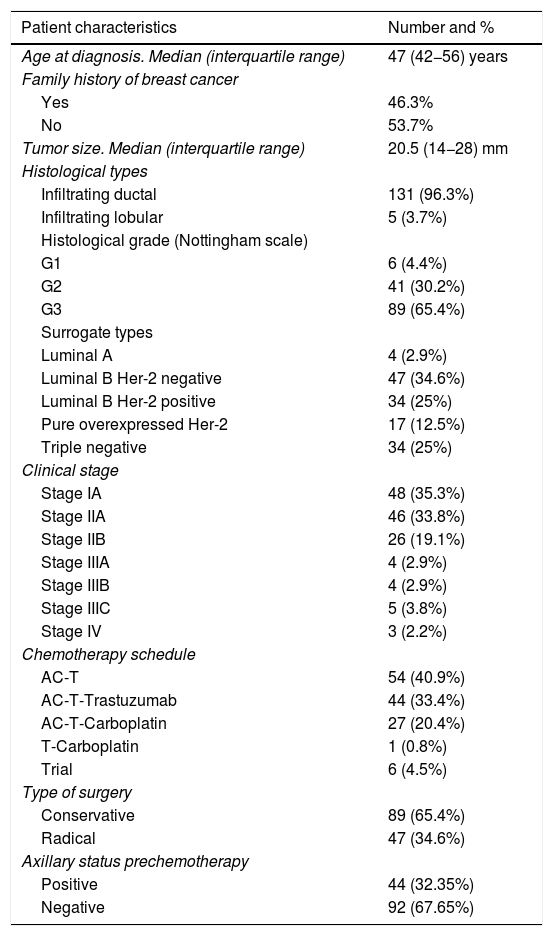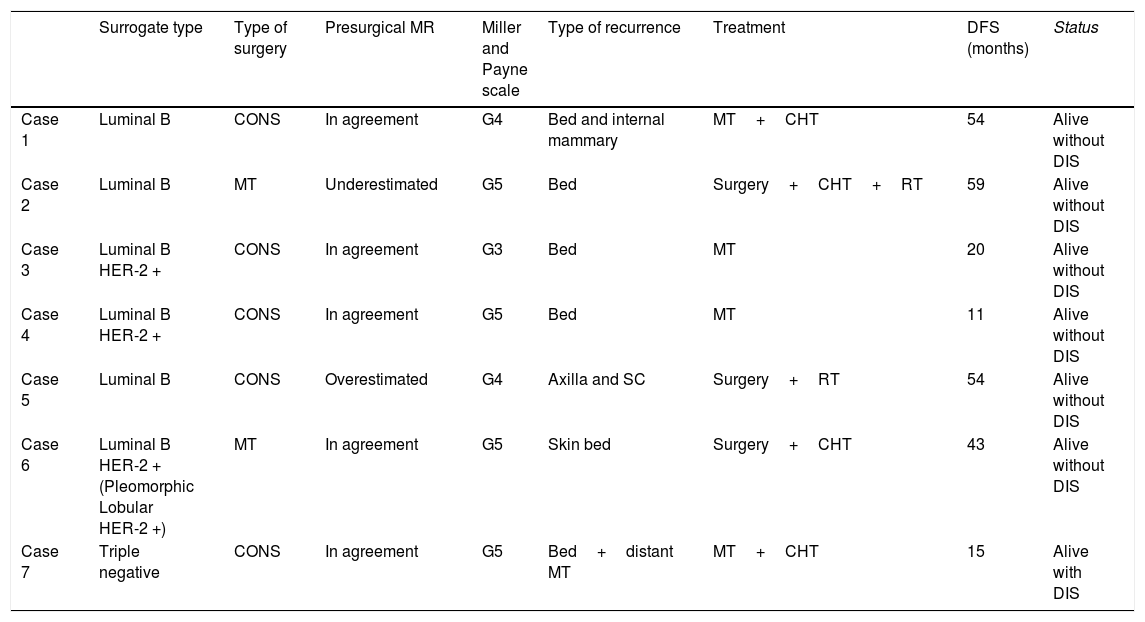To describe the results of MRI (Magnetic Resonance Image) guided ROLL (Radioguided Occult Lesion Localization) and SNOLL (Sentinel Node Occult Lesion Localization) in the localization of residual disease after neoadjuvant chemotherapy for breast cancer, as well as assessing the surgical results obtained and disease free survival.
MethodsProspective observational analysis of 132 patients with 136 tumors, treated with neoadjuvant chemotherapy at our Hospital between 2011−2017. Residual disease was localized with MRI guided ROLL/SNOLL technique. We analyzed technical aspects of localization, and variables corresponding to surgical procedures and events occurred during follow-up.
ResultsThe median tumor size was of 20,5mm (Interquartilic Range (IQR): 14−28). The majority (96,3%) were invasive ductal carcinomas. Sentinel lymph node detection rate was 98,9%. Complete pathological response (CPR) in the breast was achieved in 58,1% of cases. The rate of affected margins in 89 cases operated by conservative surgery was 2,2%. With a median follow-up of 50 months (IQR: 37–61) we found a 7,4% rate of relapses. Of these, 7 were loco-regional and 3 at distant sites. The estimated mean of disease-free survival time was 83,2 months (Confidence Interval (CI) 95%: 79.6–86,6).
ConclusionsMRI guided ROLL/SNOLL is a great tool for breast cancer residual disease localization following neoadjuvant chemotherapy. In addition, this technique attains good loco-regional control of the diseases and has excellent surgical results.
Describir las técnicas “Radioguided Occult Lesion Localization” (ROLL) y “Sentinel Node Occult Lesion Localization” (SNOLL) guiadas por resonancia magnética (RM) para el marcaje de restos tumorales en pacientes con cáncer infiltrante de mama que han recibido quimioterapia neoadyuvante y presentar los resultados quirúrgicos y la supervivencia libre de enfermedad.
Material y métodosEstudio observacional prospectivo de 132 pacientes correspondientes a 136 tumores, tratadas con quimioterapia neoadyuvante en nuestro Hospital entre los años 2011 y 2017 y marcadas preoperatoriamente con ROLL/SNOLL guiado con RM. Se describieron los aspectos técnicos de localización del lecho tumoral residual, y se registraron variables correspondientes a los procedimientos quirúrgicos y eventos ocurridos durante el seguimiento.
ResultadosLa mediana de tamaño tumoral fue 20,5mm (Rango InterCuartílico (RIC):14−28). El 96,3% eran carcinomas ductales infiltrantes. La tasa de detección de ganglio centinela fue 98,9% y se obtuvo respuesta completa patológica (RCP) en el 58,1%. La tasa de bordes afectos en los 89 casos operados mediante cirugía conservadora fue del 2,2%. Con una mediana de seguimiento de 50 meses (RIC: 37–61) se observó un 7,4% de recaídas, 7 locoregionales y 3 a distancia. La media estimada de supervivencia libre de enfermedad fue de 83,2 meses (Intervalo de Confianza (IC) 95%: 79,6–86,6)
ConclusionesLa técnica ROLL/SNOLL guiada con RM es útil en el marcaje de los restos tumorales tras neoadyuvancia, proporcionando unos resultados quirúrgicos adecuados y un buen control locoregional.
Article

Revista Española de Medicina Nuclear e Imagen Molecular (English Edition)












